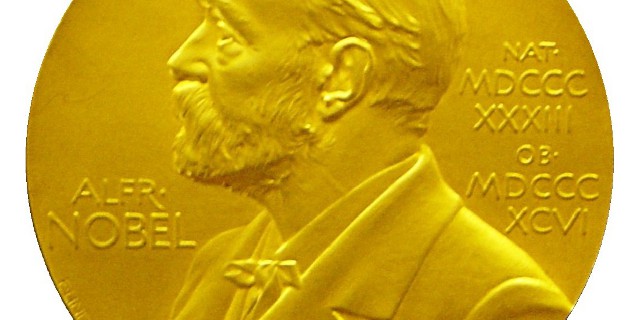To commemorate the Lindau Nobel Meeting – a gathering of Nobel laureates held in Lindau, Germany – the Scientific American blog looked at “sentence[s] that … best represents [laureates’] Nobel prize-winning work.” They mainly focused on the Physiology or Medicine and Chemistry prizes and I thought it would be interesting to try and do the same for some of the recent Physics prizes.
Obviously the idea of boiling down Nobel prize-winning work to one sentence is impossible, and many people will argue with my choices, but these are my best attempts. I’d love to hear your feedback in the comments below.
Andre Geim and Konstantin Novoselov for the discovery of graphene (2010):
“We describe monocrystalline graphitic films, which are a few atoms thick but are nonetheless stable under ambient conditions, metallic, and of remarkably high quality.”
Novoselov, K. et al. 2004. “Electric Field Effect in Atomically Thin Carbon Films”. Science 306(5696): 666–669. doi: 10.1126/science.1102896.
Charles Kao for his work on optical fibres (2009):
“Theoretical and experimental studies indicate that a fibre of glassy material constructed in a cladded structure with a core diameter of about λ0 and an overall diameter of about 100λ0 represents a possible practical optical waveguide with important potential as a new form of communication medium.”
Kao, K. C.; Hockham, G.A. (1966). “Dielectric-fibre surface waveguides for optical frequencies”. Proc. IEE 113(7): 1151–1158. doi: 10.1049/ip-j:19860030.
Willard Boyle and George Smith for the creation of the CCD (2009):
“In this paper we describe a new semiconductor device concept. Basically, it consists of storing charge in potential wells created at the surface of a semiconductor and moving the charge (representing information) over the surface by moving the potential minima.”
Boyle, W. and Smith G. 1970. “Charge Coupled Semiconductor Devices”. Bell System Technical Journal 49(4): 587-593. Link.
Albert Fert and Peter Grünberg for the discovery of giant magnetoresistance (2007):
“We have studied the magnetoresistance of (001)Fe/(001)Cr superlattices prepared by molecular beam epitaxy. A huge magnetoresistance is found in superlattices with thin Cr layers.”
Fert, Albert; et al. 1988. “Giant Magnetoresistance of Fe/Cr Magnetic Superlattices”. Physical Review Letters 61(21): 2472–2475. doi: 10.1103/PhysRevLett.61.2472.
“The electrical resistivity of Fe-Cr-Fe layers with antiferromagnetic interlayer exchange increases when the magnetizations of the Fe layers are aligned antiparallel. The effect is much stronger than the usual anisotropic magnetoresistance and further increases in structures with more than two Fe layers.”
Binasch, G., Grünberg, P., Saurenbach, F. and Zinn, W. 1989. “Enhanced magnetoresistance in layered magnetic structures with antiferromagnetic interlayer exchange”. Phys. Rev. B 39(7): 4828–4830. doi: 10.1103/PhysRevB.39.4828.
David Gross, David Politzer and Frank Wilczek for a discovery regarding the nature of the strong force that binds quarks together in the nucleus (2004):
“It is shown that a wide class of non-Abelian gauge theories have, up to calculable logarithmic corrections, free-field-theory asymptotic behaviour.”
Gross, D. and Wilczek, F. 1973. “Ultraviolet Behaviour of Non-Abelian Gauge Theories”. Phys. Rev. Lett. 30(26):1343-1346 doi: 10.1103/PhysRevLett.30.1343
“An explicit calculation shows perturbation theory to be arbitrarily good for the deep Euclidean Green’s functions of any Yang-Mills theory and of many Yang-Mills theories with fermions. Under the hypothesis that spontaneous symmetry breakdown is of dynamical origin, these symmetric Green’s functions are the asymptotic forms of the physically significant spontaneously broken solution, whose coupling could be strong.”
Politzer, H.D. 1973. “Reliable Pertubative Results for Strong Interactions?”. Phys. Rev. Lett. 30(26): 1346-1349. doi: 10.1103/PhysRevLett.30.1346.
Steven Chu, Claude Cohen-Tannoudji and William Daniel Phillips for their work on laser cooling (1997):
“A variety of powerful techniques to control the position and velocity of neutral particles has been developed. As examples of this new ability, lasers have been used to construct a variety of traps, to cool atoms to temperatures below 3 μK, and to create atomic fountains that may give us a hundredfold increase in the accuracy of atomic clocks.”
Chu, S. 1991 “Laser Manipulation of Atoms and Particles”. Science 253(5022): 861-866. doi: 10.1126/science.253.5022.861.
Douglass Osheroff and Robert Richardson for the discovery of superfluidity in helium-3 (1996):
“Measurements of the melting pressure of a sample of He3 … indicate the existence of a new phase in solid He3 below 2.7 mK of a fundamentally different nature than the anticipated antiferromagnetically ordered state.”
Osheroff, D., Richardson, R. and Lee, D. 1972. “Evidence for a New Phase of Solid He3”. Physical Review Letters 28(14): 885–888. doi:10.1103/PhysRevLett.28.885.
Can you suggest any other Nobel prize-winning sentences?



